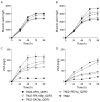Metabolic Engineering and Process Intensification for Muconic Acid Production Using Saccharomyces cerevisiae
- PMID: 39408575
- PMCID: PMC11476194
- DOI: 10.3390/ijms251910245
Metabolic Engineering and Process Intensification for Muconic Acid Production Using Saccharomyces cerevisiae
Abstract
The efficient production of biobased organic acids is crucial to move to a more sustainable and eco-friendly economy, where muconic acid is gaining interest as a versatile platform chemical to produce industrial building blocks, including adipic acid and terephthalic acid. In this study, a Saccharomyces cerevisiae platform strain able to convert glucose and xylose into cis,cis-muconic acid was further engineered to eliminate C2 dependency, improve muconic acid tolerance, enhance production and growth performance, and substantially reduce the side production of the intermediate protocatechuic acid. This was achieved by reintroducing the PDC5 gene and overexpression of QDR3 genes. The improved strain was integrated in low-pH fed-batch fermentations at bioreactor scale with integrated in situ product recovery. By adding a biocompatible organic phase consisting of CYTOP 503 and canola oil to the process, a continuous extraction of muconic acid was achieved, resulting in significant alleviation of product inhibition. Through this, the muconic acid titer and peak productivity were improved by 300% and 185%, respectively, reaching 9.3 g/L and 0.100 g/L/h in the in situ product recovery process as compared to 3.1 g/L and 0.054 g/L/h in the control process without ISPR.
Keywords: Saccharomyces cerevisiae; in situ product recovery; metabolic engineering; muconic acid; reactive extraction; yeast cell factory.
Conflict of interest statement
Authors Sinah Tönjes, Evelien Uitterhaegen, Karel De Winter and Wim Soetaert were employed by the company Bio Base Europe Pilot Plant (BBEPP). The remaining authors declare that the research was conducted in the absence of any commercial or financial relationships that could be construed as a potential conflict of interest.
Figures





Similar articles
-
In-situ muconic acid extraction reveals sugar consumption bottleneck in a xylose-utilizing Saccharomyces cerevisiae strain.Microb Cell Fact. 2021 Jun 7;20(1):114. doi: 10.1186/s12934-021-01594-3. Microb Cell Fact. 2021. PMID: 34098954 Free PMC article.
-
Improvement of cis,cis-Muconic Acid Production in Saccharomyces cerevisiae through Biosensor-Aided Genome Engineering.ACS Synth Biol. 2020 Mar 20;9(3):634-646. doi: 10.1021/acssynbio.9b00477. Epub 2020 Feb 14. ACS Synth Biol. 2020. PMID: 32058699 Free PMC article.
-
Biosensor-Enabled Directed Evolution to Improve Muconic Acid Production in Saccharomyces cerevisiae.Biotechnol J. 2017 Oct;12(10). doi: 10.1002/biot.201600687. Epub 2017 Aug 24. Biotechnol J. 2017. PMID: 28296355
-
Recent Advances in Microbial Production of cis,cis-Muconic Acid.Biomolecules. 2020 Aug 25;10(9):1238. doi: 10.3390/biom10091238. Biomolecules. 2020. PMID: 32854378 Free PMC article. Review.
-
D-Xylose Sensing in Saccharomyces cerevisiae: Insights from D-Glucose Signaling and Native D-Xylose Utilizers.Int J Mol Sci. 2021 Nov 17;22(22):12410. doi: 10.3390/ijms222212410. Int J Mol Sci. 2021. PMID: 34830296 Free PMC article. Review.
Cited by
-
Recent advances in genetic engineering and chemical production in yeast species.FEMS Yeast Res. 2025 Jan 30;25:foaf009. doi: 10.1093/femsyr/foaf009. FEMS Yeast Res. 2025. PMID: 40082732 Free PMC article. Review.
-
Recent advances of muconic acid production using microbial synthetic biology.Arch Microbiol. 2025 Aug 11;207(9):221. doi: 10.1007/s00203-025-04419-8. Arch Microbiol. 2025. PMID: 40788366 Review.
References
-
- Rorrer N.A., Dorgan J.R., Vardon D.R., Martinez C.R., Yang Y., Beckham G.T. Renewable Unsaturated Polyesters from Muconic Acid. ACS Sustain. Chem. Eng. 2016;4:6867–6876. doi: 10.1021/acssuschemeng.6b01820. - DOI
-
- Zanella E., Secundo L., Bellomi S., Vomeri A., Villa A., Pirola C. Bio-Adipic Acid Production from Muconic Acid Hydrogenation on Palladium-Transition Metal (Ni and Zn) Bimetallic Catalysts. Catalysts. 2023;13:486. doi: 10.3390/catal13030486. - DOI
-
- Rosini E., Molinari F., Miani D., Pollegioni L. Lignin Valorization: Production of High Value-Added Compounds by Engineered Microorganisms. Catalysts. 2023;13:555. doi: 10.3390/catal13030555. - DOI
MeSH terms
Substances
Grants and funding
LinkOut - more resources
Full Text Sources
Miscellaneous

